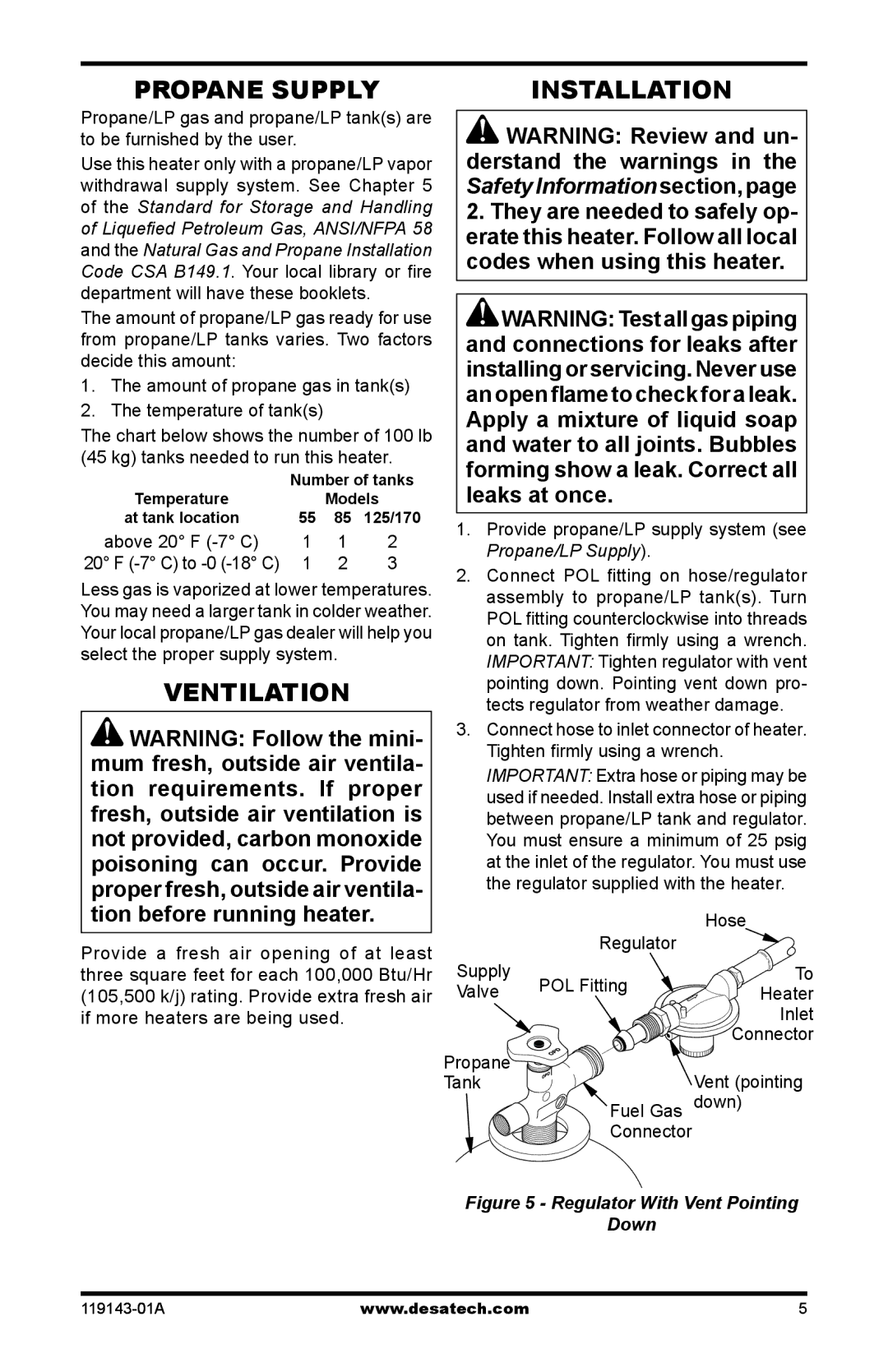
Propane Supply | Installation |
Propane/LP gas and propane/LP tank(s) are to be furnished by the user.
Use this heater only with a propane/LP vapor withdrawal supply system. See Chapter 5 of the Standard for Storage and Handling of Liquefied Petroleum Gas, ANSI/NFPA 58 and the Natural Gas and Propane Installation Code CSA B149.1. Your local library or fire department will have these booklets.
The amount of propane/LP gas ready for use from propane/LP tanks varies. Two factors decide this amount:
1.The amount of propane gas in tank(s)
2.The temperature of tank(s)
The chart below shows the number of 100 lb (45 kg) tanks needed to run this heater.
| number of tanks | ||
Temperature |
| Models | |
at tank location | 55 | 85 | 125/170 |
above 20° F | 1 | 1 | 2 |
20° F | 1 | 2 | 3 |
Less gas is vaporized at lower temperatures. You may need a larger tank in colder weather. Your local propane/LP gas dealer will help you select the proper supply system.
Ventilation
![]() WARNING: Follow the mini- mum fresh, outside air ventila- tion requirements. If proper fresh, outside air ventilation is not provided, carbon monoxide poisoning can occur. Provide proper fresh, outside air ventila- tion before running heater.
WARNING: Follow the mini- mum fresh, outside air ventila- tion requirements. If proper fresh, outside air ventilation is not provided, carbon monoxide poisoning can occur. Provide proper fresh, outside air ventila- tion before running heater.
Provide a fresh air opening of at least three square feet for each 100,000 Btu/Hr (105,500 k/j) rating. Provide extra fresh air if more heaters are being used.
![]() WARNING: Review and un- derstand the warnings in the Safety Information section, page
WARNING: Review and un- derstand the warnings in the Safety Information section, page
2.They are needed to safely op- erate this heater. Follow all local codes when using this heater.
![]() WARNING:Testallgaspiping and connections for leaks after installing or servicing. Never use an open flame to check for a leak. Apply a mixture of liquid soap and water to all joints. Bubbles forming show a leak. Correct all leaks at once.
WARNING:Testallgaspiping and connections for leaks after installing or servicing. Never use an open flame to check for a leak. Apply a mixture of liquid soap and water to all joints. Bubbles forming show a leak. Correct all leaks at once.
1.Provide propane/LP supply system (see
Propane/LP Supply).
2.Connect POL fitting on hose/regulator assembly to propane/LP tank(s). Turn
POL fitting counterclockwise into threads on tank. Tighten firmly using a wrench. IMPORTANT: Tighten regulator with vent pointing down. Pointing vent down pro- tects regulator from weather damage.
3.Connect hose to inlet connector of heater.
Tighten firmly using a wrench.
IMPORTANT: Extra hose or piping may be used if needed. Install extra hose or piping between propane/LP tank and regulator.
You must ensure a minimum of 25 psig at the inlet of the regulator. You must use the regulator supplied with the heater.
|
| Hose | |
| Regulator |
| |
Supply | POL Fitting | To | |
Valve | Heater | ||
| |||
|
| Inlet | |
|
| Connector | |
Propane |
| Vent (pointing | |
Tank |
| ||
| Fuel Gas | down) | |
| Connector |
|
